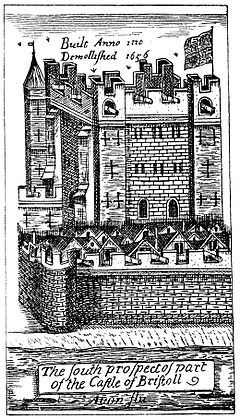Bristol Castle
| Bristol Castle | |
|---|---|

Bristol Castle from James Millerd's map of Bristol in 1673
|
|
|
Location within Bristol
|
|
| General information | |
| Town or city | Bristol |
| Country | England |
| Coordinates | 51°27′21″N 2°35′18″W / 51.4559°N 2.5883°W |
| Client | William the Conqueror |
| Design and construction | |
| Architect | Robert, 1st Earl of Gloucester |
Bristol Castle was a Norman castle built for the defence of Bristol. Remains can be seen today in Castle Park near the Broadmead Shopping Centre, including the sally port.
The first castle built at Bristol was a timber motte and bailey, presumably erected on the command of William the Conqueror, who owned Bristol. One of William's closest allies, Geoffrey de Montbray, Bishop of Coutances, appears to have had control of the castle in William's name. The Domesday Book notes that he received part of the king's income from the borough. The castle is first mentioned in 1088, when Geoffrey used it as a base in his rebellion against William Rufus.
After William triumphed, the English lands of the rebels were redistributed to his loyal followers. Among them was Robert Fitzhamon, who gained a large swathe of Gloucestershire, including Bristol Castle. His eldest daughter Mabel married Robert, illegitimate son of Henry I. She brought him the honour of Gloucester on the death of her father in 1107. So he is generally known as Robert of Gloucester.
By this time many of the first wave of Norman timber castles were being replaced in stone. Bristol Castle was a fine example with curtain walls and a great keep. It seems that Robert of Gloucester was the man responsible. The castle was built on a strategic site to the east of the town, between the River Avon and the River Frome, which was partly diverted to form the castle moat.
...
Wikipedia

